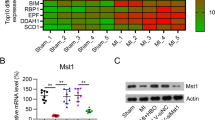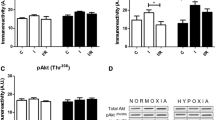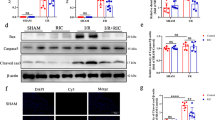Abstract
Postconditioning (PostC) has regenerated interest as a mechanical intervention against myocardial ischemia/reperfusion injury, but its molecular mechanisms remain elusive. This study tested the hypothesis that hypoxia inducible factor-1α (HIF-1α) plays a role in PostC-induced cardioprotection. Male Wistar rats were subjected to 30 min ischemia followed by 3 h of reperfusion (Control). PostC with 3 cycles of 10 s reperfusion and 10 s re-occlusion was applied at the onset of reperfusion. Relative to the Sham group, HIF-1α protein level was increased by 2.9-fold in the Control group, but its level was enhanced by 5.8-fold with PostC (P < 0.01 vs. Control). However, HIF-1α protein level was further augmented by 2.0-fold and 3.3-fold, respectively, when the prolyl hydroxylase inhibitor, dimethyloxalylglycine (DMOG, 40 mg/kg, i.p.) was given at 24 h before ischemia in both Control and PostC groups. PostC reduced infarct size by 24% compared with the Control (27 ± 4.2% vs. 36 ± 5.2%, P < 0.01), consistent with significant lower levels of plasma creatine kinase activity, index of cardiomyocyte apoptosis and caspase-3 activity. Although pretreatment with DMOG significantly reduced infarct size relative to the Control, the infarct-sparing effect of PostC was remarkably enhanced when DMOG was given before PostC (18 ± 2.0% vs. 27 ± 4.2% in PostC alone, P < 0.05). There was a significant linear inverse relationship between HIF-1α protein level and infarct size (r = −0.799, P < 0.01) among all groups. Furthermore, along with up-regulated HIF-1α expression, the levels of iNOS mRNA and protein were significantly increased in the PostC alone and DMOG plus PostC groups. In conclusion, these data suggest that HIF-1α is involved in cardioprotection by PostC and pharmacological augmentation of HIF-1α expression that enhances the infarct-sparing effect of PostC; iNOS, the downstream gene of HIF-1α, may participate in signaling pathways in mediating PostC’s protection.








Similar content being viewed by others
References
Argaud L, Gateau-Roesch O, Augeul L, Couture-Lepetit E, Loufouat J, Gomez L, Robert D, Ovize M (2008) Increased mitochondrial calcium coexists with decreased reperfusion injury in postconditioned (but not preconditioned) hearts. Am J Physiol Heart Circ Physiol 294:H386–H391
Argaud L, Gateau-Roesch O, Raisky O, Loufouat J, Robert D, Ovize M (2005) Postconditioning inhibits mitochondrial permeability transition. Circulation 111:194–197
Boldt A, Scholl A, Garbade J, Resetar ME, Mohr FW, Gummert JF, Dhein S (2006) ACE-inhibitor treatment attenuates atrial structural remodeling in patients with lone chronic atrial fibrillation. Basic Res Cardiol 101:261–267
Brüne B, Zhou J (2007) Nitric oxide and superoxide: interference with hypoxic signaling. Cardiovasc Res 75:275–282
Cuong DV, Kim N, Youm JB, Joo H, Warda M, Lee JW, Park WS, Kim T, Kang S, Kim H, Han J (2006) Nitric oxide-cGMP-protein kinase G signaling pathway induces anoxic preconditioning through activation of ATP-sensitive K+ channels in rat hearts. Am J Physiol Heart Circ Physiol 290:H1808–H1817
Donato M, D’Annunzio V, Berg G, Gonzalez G, Schreier L, Morales C, Wikinski RL, Gelpi RJ (2007) Ischemic postconditioning reduces infarct size by activation of A1 receptors and K+ATP channels in both normal and hypercholesterolemic rabbits. J Cardiovasc Pharmacol 49:287–292
Heusch G, Boengler K, Schulz R (2008) Cardioprotection: nitric oxide, protein kinases, and mitochondria. Circulation 118:1915–1919
Iliodromitis EK, Georgiadis M, Cohen MV, Downey JM, Bofilis E, Kremastinos DT (2006) Protection from postconditioning depends on the number of short ischemic insults in anesthetized pigs. Basic Res Cardiol 101:502–507
Jones SP, Bolli R (2006) The ubiquitous role of nitric oxide in cardioprotection. J Mol Cell Cardiol 40:16–23
Ke Q, Costa M (2006) Hypoxia inducible factor-1 (HIF-1). Mol Pharmacol 70:1469–1480
Kin H, Zatta AJ, Lofye MT, Amerson BS, Halkos ME, Kerendi F, Zhao ZQ, Guyton RA, Headrick JP, Vinten-Johansen J (2005) Postconditioning reduces infarct size via adenosine receptor activation by endogenous adenosine. Cardiovasc Res 67:124–133
Lee SH, Wolf PL, Escudero R, Deutsch R, Jamieson SW, Thistlethwaite PA (2000) Early expression of angiogenesis factors in acute myocardial ischemia and infarction. N Engl J Med 342:626–633
Lim SY, Davidson SM, Hausenloy DJ, Yellon DM (2007) Preconditioning and postconditioning: the essential role of the mitochondrial permeability transition pore. Cardiovasc Res 75:530–535
Mykytenko J, Kerendi F, Reeves JG, Kin H, Zatta AJ, Jiang R, Guyton RA, Vinten-Johansen J, Zhao ZQ (2007) Long-term inhibition of myocardial infarction by postconditioning during reperfusion. Basic Res Cardiol 102:90–100
Mykytenko J, Reeves JG, Kin H, Wang NP, Zatta AJ, Jiang R, Guyton RA, Vinten-Johansen J, Zhao ZQ (2008) Persistent beneficial effect of postconditioning against infarct size: role of mitochondrial K(ATP) channels during reperfusion. Basic Res Cardiol 103:472–484
Ockaili R, Natarajan R, Salloum F, Fisher BJ, Jones D, Fowler AA 3rd, Kukreja RC (2005) HIF-1 activation attenuates postischemic myocardial injury: role for heme oxygenase-1 in modulating microvascular chemokine generation. Am J Physiol Heart Circ Physiol 289:542–548
Philipp S, Yang X-M, Cui L, Davis AM, Downey JM, Cohen MV (2006) Postconditioning protects rabbit hearts through a protein kinase C-adenosine A2b receptor cascade. Cardiovasc Res 70:308–314
Qing M, Görlach A, Schumacher K, Wöltje M, Vazquez-Jimenez JF, Hess J, Seghaye MC (2007) The hypoxia inducible factor HIF-1 promotes intramyocardial expression of VEGF in infants with congenital cardiac defects. Basic Res Cardiol 102:224–232
Rosenberger P, Schwab JM, Mirakaj V, Masekowsky E, Mager A, Morote-Garcia JC, Unertl K, Eltzschig HK (2008) Hypoxia inducible factor–dependent induction of netrin-1 dampens inflammation caused by hypoxia. Nature Immunology 10:195–202
Semenza GL (2004) Hydroxylation of HIF-1: oxygen sensing at the molecular level. Physiology (Bethesda) 19:176–182
Sivaraman V, Mudalagiri NR, Di Salvo C, Kolvekar S, Hayward M, Yap J, Keogh B, Hausenloy DJ, Yellon DM (2007) Postconditioning protects human atrial muscle through the activation of the RISK pathway. Basic Res Cardiol 102:453–459
Skyschally A, van Caster P, Boengler K, Gres P, Musiolik J, Schilawa D, Schulz R, Heusch G (2009) Ischemic postconditioning in pigs: no causal role for RISK activation. Circ Res 104:15–18
Sun HY, Wang NP, Halkos M, Kerendi F, Kin H, Guyton RA, Vinten-Johansen J, Zhao ZQ (2006) Postconditioning attenuates cardiomyocyte apoptosis via inhibition of JNK and p38 mitogen-activated protein kinase signaling pathways. Apoptosis 11:1583–1593
Tsang A, Hausenloy DJ, Macanu MM, Yellon DM (2004) Postconditioning-A form of ‘‘modified reperfusion’’ protects the myocardium by activating the P13 K-Akt pathway. Circulation 110:III167
Wang GL, Jiang BH, Rue EA, Semenza GL (1995) Hypoxia-inducible factor 1 is a basic-helix-loop-helix-PAS heterodimer regulated by cellular O2 tension. Proc Natl Acad Sci 92:5510–5514
Wang X-L, Liu H-R, Tao L, Liang F, Yan L, Zhao R-R, Lopezb BL, Christopher TA, Ma X-L (2007) Role of iNOS-derived reactive nitrogen species and resultant nitrative stress in leukocytes-induced cardiomyocyte apoptosis after myocardial ischemia/reperfusion. Apoptosis 12:1209–1217
Yellon DM, Opie LH (2006) Postconditioning for protection of the infarcting heart. Lancet 367:456–458
Yoshida A, Suzuki N, Nakano Y, Oho T, Kawada M, Koga T (2003) Development of a 5′ fluorogenic nuclease-based real time-PCR assay for quantitative detection of Actinobacillus actinomycetemcomitans and Porphyromonas gingivalis. J Clin Microbiol 41:863–866
Zhao ZQ, Corvera JS, Halkos ME, Kerendi F, Wang NP, Guyton RA, Vinten-Johansen J (2003) Inhibition of myocardial injury by ischemic postconditioning during reperfusion: comparison with ischemic preconditioning. Am J Physiol Heart Circ Physiol 285:H579–H588
Acknowledgments
This work was supported in part by National Nature Scientific Foundation of People’s Republic of China (No.30572084 to Hui-Rong Liu, No.30700276 to Xiao-Liang Wang), and award of Technological Innovation of Taiyuan City (08122085 to Huan-Xin Zhao).
Author information
Authors and Affiliations
Corresponding author
Rights and permissions
About this article
Cite this article
Zhao, HX., Wang, XL., Wang, YH. et al. Attenuation of myocardial injury by postconditioning: role of hypoxia inducible factor-1α. Basic Res Cardiol 105, 109–118 (2010). https://doi.org/10.1007/s00395-009-0044-0
Received:
Revised:
Accepted:
Published:
Issue Date:
DOI: https://doi.org/10.1007/s00395-009-0044-0




